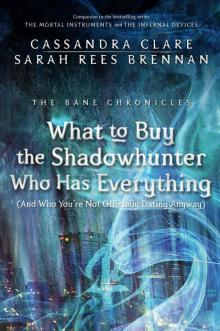- Home
- Cassandra Clare
Shadowhunter’s Codex Page 6
Shadowhunter’s Codex Read online
Page 6
In addition to their general hideousness, demons often carry with them a scent of death that can be very strong. Shadowhunters asked to describe it usually reach for terms like “rotting,” “spoiled,” “brimstone,” “burning hair,” and the like. The effect can be debilitating to the unprepared Shadowhunter.
I am actually feeling kind of bad for demons here. Is that wrong?
Yes.
WHAT IS THAT DISGUSTING BLACK LIQUID THAT APPEARS WHEN YOU CUT THEM?
Like other living creatures, demons’ bodies are kept fresh by a vital fluid, but this is not the usual red blood of our world. Instead, they contain a supernatural ichor. The term “ichor” refers originally to the golden blood of angels, and comes from the ancient Greek word for the blood of their gods. Demon blood is also ichor, but as it is infused with demon energies, it is black and viscous, thinner than blood but totally opaque. Ichor is not dangerous to touch, but it is somewhat toxic to humans if it gets into the blood via a wound or other means. It is unlikely to harm any Shadowhunter who has the usual range of protective Marks, but care should be taken.
CAN DEMONS SPEAK HUMAN LANGUAGES?
Most common demons cannot speak human languages. A good number of species are, however, able to parrot human speech that they have heard. This is often a sign that a demon has been summoned rather than coming to our world on its own; the demon will be heard to repeat, often obsessively, words and phrases spoken to it by the summoner.
There are a number of demon languages—possibly an infinite number of them—but a number that we have identified and that warlocks and, more rarely, Shadowhunters interested in demon research may learn. The two most common are known to demon philologists as Cthonic and Purgatic. It is worthwhile to at least be able to recognize these two languages in their written and spoken forms, and perhaps to memorize a few frequently used phrases, such as “Hello,” “Good-bye,” “I am a Nephilim,” “In the name of Raziel I abjure thee,” “Begone, fiend,” and so on.
DO DEMONS POSSESS PEOPLE?
Despite the mundane obsession with demons taking possession of their bodies, actual demon possession is very rare and requires a very powerful Greater Demon. This is lucky, because it is one of the most powerful magics that demons possess. Usually the only way the connection between the possessor and the possessed can be broken is by killing the demon, which more often than not kills the hapless mundane victim as well. If you encounter a possession, do not try to handle the situation on your own. Do not try to negotiate with the possessed as if they are political hostages. The possessed are not merely corrupted by demonic influence but are fully controlled. They become like passengers in their own bodies, able to experience everything that the demon is doing but unable to exert any will to act independently at all. (Mercifully, the possessed usually retain no memories of their actions while inhabited.) You may restrain the victim, preferably with help from other Shadowhunters, and then you should contact the Silent Brothers and allow them to remove the subject to the Silent City, where they will perform magics that you are better off not witnessing.
WHY ARE DEMONS SO EAGER TO DESTROY US?
It’s believed that demons have an intrinsic hatred of us as a result of their envy of the life of our dimension. Theirs, as far as we can tell, is a dead dimension, a dimension devoid of life, and they desire to consume us and our world to take that which they themselves do not (or, perhaps, no longer) have. Demons are able to sense the presence of life nearby; in fact, they will often use this sense to track down their prey.
* * *
DID YOU KNOW?
One of the great unsung heroes of the Nephilim is Gregory Hans, a seventeenth-century Silent Brother who discovered the correct combination of Marks to both enhance a Nephilim’s senses and exclude the smell of demons from that enhancement. Generations of Shadowhunters thank him. (Note that under standard demonic glamour, those who are susceptible cannot smell a demon any more than they can hear or see one. All the senses, thankfully, are negated.)
HOW DO WE KILL THEM?
The most important weakness of demons is, of course, their vulnerability to angelic power and heavenly fire. Like the Downworlders they brought into being, they cannot easily be harmed by normal earthly weapons, or at least not permanently harmed. For this reason you will find even the most basic Shadowhunter weapons to be Marked to strengthen them against demons, and you will find the seraph blade (see Treasury, Chapter 1) to be the most important of your tools in combat.
In addition to being repelled by direct seraphic energy, most demons can be warded off with holy symbols of all kinds. Very powerful demons, however, such as Greater Demons, may be caused only discomfort by the presence of holy symbols, rather than actual harm, so a Shadowhunter should not depend exclusively on these symbols to protect themselves.
Like vampires, demons cannot stand the direct force of sunlight upon their bodies. Note that—just as in the case of vampires—this does not mean that demons are not active during daylight hours. They can stand our artificial lights with no ill effects. And unlike vampires, who often attempt to live undetected among mundanes, demons have no need to pretend to tolerate sunlight. It is possible to destroy a demon with light, but the Shadowhunter will need to somehow entrap the demon in a situation where sunlight cannot be escaped, which can be difficult. A seraph blade to the throat or heart is usually a more reliable attack.
Finally, one great advantage that we have in our fight against demons is that they are unable to perceive the difference between mundanes and Shadowhunters, and unable to sense the working of angelic magic. This enables us to hide from them using glamours until such time as we are ready to fight them. Demons can, however, detect the presence of other demons and Downworlders.
This section summarized for your convenience: We don’t know a thing about either of these.
THE VOID AND THE DEMON CITY OF PANDEMONIUM
Well, that is a time saver, thanks.
We know little about the Void, the home of demonkind. Many names have been used in literature to refer to the home of the demons—all mundane religious terms for Hell, and other abstract terms such as “Chaos” and “Abyss,” for example—but in modern times we have settled on “Void” as both descriptive and ecumenical, and, oddly enough, the Greater Demons who have manifested in our world in modern times have also used the term.
The geography of the Void remains a mystery to us. It often appears that demons have no real homes and are present everywhere at all times. One can, for instance, summon any demon for whom a summoning ritual is known, and all of these demons will appear reliably and in roughly the same amount of time, whatever kind of demon and wherever the summoner may be. On the other hand, certain species of demons tend to “naturally” occur in certain parts of our world—the Rakshasas of the Indian subcontinent, for example, or the Gorgons of Greece. Plenty of theories have been advanced as to why this might be, but the fact is that we do not understand why certain demons have an affinity for certain locations. The fact that some demons do have an affinity for a location is to our advantage, though. Those Shadowhunters posted in certain places will become experts in fighting particular kinds of demons and for the most part will not have to know everything about all demons but will be able to locally specialize.
One may generally assume that the number of different demons in the Void is, for all intents and purposes, infinite. At the very least, it’s believed that there are hundreds upon hundreds of millions of different types, and while Shadowhunters have fought demons for the entirety of our thousand-year history, it’s unlikely that we’ve encountered more than the tiniest percentage of them. It’s speculated that there are many demons who are incapable of manifesting themselves materially in our world at all.
A constant in our communication with those demons who can speak human language is their references to the city of Pandemonium, the supposed great nexus of demons at the center of the Void, if a void can be said to have a center. No human has, of course,
ever visited that city and returned to tell the tale, so it is impossible to make any definite statements about it and what it is like, or even to say whether it can be described as a physical entity in the manner of our cities at all. About the only thing we can say about Pandemonium definitely is that it is very, very large—staggeringly larger than any of our human cities, and possibly larger and more populous than Earth. Research on Pandemonium has been limited, largely because most Nephilim consider that there are enough demons present in our world without going to find still more of them.
* * *
DEMONS VERSUS GREATER DEMONS
We do not know if there are actually “Greater Demons.”
There are specific demons that we refer to as Greater Demons, and they have some aspects in common: human-scale intelligence, personalities, names, and an inability to be permanently destroyed by us with any weapon available. We know this because of a long recorded history of Greater Demons who have been “killed,” only to return later, intact and unharmed. Void Theory tells us that the destruction of the Greater Demon’s physical body sends the Greater Demon snapping back to the spaces in the Void, where its ethereal body exists. There the Greater Demon must spend time carefully accruing power in order to rebuild its physical form.
But it’s important also to remember that this is mostly speculation. It may be the case, for instance, that no demons, Greater or otherwise, can be permanently killed by us, but since we can’t discern individuals among the demons that have subhuman intelligence, we cannot tell if a demon we believe we have killed actually returns later. Attempts have been made at various points in history to “tag” individual demons for tracking, usually with terrible results. Killing demons is difficult enough; catching a small number alive in order to tag and track them has proven impossible.
It is possible, therefore, that “Greater Demon” simply means “any demon with humanlike intelligence,” rather than the term indicating some firmer distinction between Greater Demons and regular demons. More research will be needed to discover the truth; luckily, the endless torrent of hideous un-life from beyond the Void shows no sign of slowing, and research material will likely never be in short supply.
DEMONS, DEMONS, DEMONS
Now with additional demons!
I. SOME GREATER DEMONS
LILITH
Unlike her dark consort, Sammael, Lilith is still alive and has been known to appear on Earth. Pray that you never meet her.
Lilith is known by many names, even when considering only the Jewish tradition from which most of her folklore is sourced. This does not count the many other entities in other mythological traditions that are similar in form or function and may or may not be the same demon. Lilith’s other names in Jewish folklore include: Satrina, Abito, Amizo, Izorpo, Kokos, Odam, Ita, Podo, Eilo, Patrota, Abeko, Kea, Kali, Batna, Talto, and Partash.
Jewish tradition says that for her disobedience she was punished by being made unable to bear children. Many versions of the tale paint an even more brutal picture in which Lilith actually is capable of birthing infants, but all of them die upon birth. As such she is associated with the harming and weakening of human babies, and much of our knowledge of Lilith comes from Jewish mystical tradition designed to protect newborns from Lilith’s influence, with amulets and incantations.
SAMMAEL
Apart from his foundational role in the Incursion, not much is known about Sammael. He is thought to have been the great Serpent by which humanity was tempted and fell from grace. But his physical shape is a mystery, for Sammael has not been seen on Earth in many hundreds of years.
Traditional tales state that for his crime of softening the veils between the human world and the Void, he was hunted and murdered by the archangel Michael, commander of the armies of Heaven. This story comes to us through mundane religious tradition, but is often repeated and is clearly believed by the demons of Pandemonium themselves. Since Sammael has not been seen in our world for so long a time, no rituals survive to summon him.
ABBADON
The Demon of the Abyss. His are the empty places between the worlds. His is the wind and the howling darkness. He is a nine-foot-tall rotting human skeleton.
He is a real jerk.
AZAZEL
Lieutenant of Hell and Forger of Weapons. Like most of the greatest of Greater Demons, he was an angel at one time. He is said to have taught humanity how to make weapons in the times before history, where previously weapons making had been knowledge held only by angels. This great transgression caused him to fall and become a demon. The irony of a demon being responsible for giving humanity the knowledge necessary to fight against demons is not lost on the Nephilim; we assume that it is not lost on Azazel himself either. As the Book of Enoch has it, “And the whole earth has been corrupted by the works that were taught by Azazel. To him ascribe all sin.”
HUNGER
The demon known as Hunger is an obese devil-like humanoid figure covered in hard, bony scales and a variety of chomping fang-lined mouths all over his body. Hunger is made to devour everything he encounters, usually in as messy and grotesque a fashion as possible.
MARBAS
A blue demon, half again the size of a man, covered in overlapping blue scales, with a long yellowish tail with a stinger on the end. Scarlet eyes, lizard’s features, and a flat snakelike snout.
MRS. DARK
A large creature of hard, stonelike skin, apparently female (although what gender means in the realm of demons is unclear). She is horned, with twisted limbs and clawed hands. She can also be identified by her glowing yellow eyes and her triple row of mouths lined with greenish fangs. She is of the Eidolon (see separate entry).
II. SOME COMMON DEMONS
BEHEMOTH
The Behemoth is a formless monstrosity of a demon. It is roughly oblong and could be described as sluglike in its movements, but with less coherence of shape. It is large, much larger than a human, and slimy. Double rows of teeth line the length of its body. The Behemoth devours everything in its path, including people.
DRAGON
Dragon demons are the closest thing in the modern world to the ancient myths of dragons. They are large, flying, fire-breathing lizards, and are quite intelligent. They come in a variety of shapes and colors. They are formidable foes; luckily, Shadowhunters are likely to never encounter them, since they are almost extinct. They are not to be confused with Vetis demons, which are like dragons but are not Dragons.
DREVAK
Shadowhunters know well the appearance of Drevaks, weak demons in frequent use by Greater Demons or evil warlocks as spies or messengers. They are smooth, white, and larval, resembling a giant version of a mundane grub or maggot. They are blind and do their tracking by scent.
Their shapelessness and lack of intelligence does not mean they are not dangerous; instead of teeth their mouths contain poisonous spines, which can be very dangerous if they break off and stick in the skin of a victim. Normal treatments for demon venom apply here.
DU’SIEN
The Du’sien is one of the lesser-known shape-shifting, or Eidolon, demon species (see below). Its true appearance is abstract, like an irregular blob of greenish-gray jelly with a small glowing black core. They cannot mimic other creatures with the detail that many Eidolon can, and their command of human language is weak. They are thus often found disguised as “generic humans,” members of a crowd, rather than impersonating specific individuals.
EIDOLON
“Eidolon” is not the name for a specific species of demon. Rather, it is a comprehensive term for a variety of shape-shifting demon species. Shape-shifting demons come in many different original shapes, and many different sizes and strengths. Since there are dozens of these species, Shadowhunters typically use the term “Eidolon” to refer to shape-shifting demons in general. It is, in other words, usually more useful to note a demon’s shape-shifting ability than the minor details of their original form.
Eidolon demons make up the majori
ty of demon parents of warlocks, for obvious reasons. (See the “Warlocks” section of Part II of this Bestiaire for an explanation if the reasons are not obvious to you.)
In addition to the danger posed by their nearly perfect ability to camouflage themselves, Eidolon also have a marked advantage over other demon species: When shifted into the form of a human, they are somewhat protected from the destructive light of the sun. A shifted Eidolon demon still cannot stand in direct sunlight but can endure the diffused light coming through heavy clouds, fog, rain, and so on, with only minor discomfort.
FACEMELTER
Self-explanatory.
HELLHOUND
A demonic corruption of the dog, just as many demons are corruptions of the forms of men and women. Typically hellhounds appear as vicious canines much larger than any mundane dog, with red eyes, coarse black wirelike fur, and a murderous temperament. They have a similar intelligence to mundane dogs and are used by demons for similar purposes—tracking and hunting. (Obviously there are many uses for mundane dogs, such as herding and companionship, that hellhounds are never used for, since demons are incapable of concepts such as companionship.) Like with dogs, hellhounds’ jaws are their most dangerous weapons, but unlike with dogs, their tails end in a set of spiked nail-like protrusions, similar to a mace.
HYDRA
A medium-size multiheaded demon, vicious but not intelligent. Known for its multiple heads, at least three but often many more. The Hydra can be distinguished from other multiheaded demons by its animalistic intelligence level, the presence of heads on stalks, and its blindness—the Hydra cannot see normally and relies on sound, scent, and its sheer number of large mouths to catch its prey.
IBLIS
The Iblis demon is corporeal but not of solid form. Instead it has the appearance of a figure about the size and shape of a human but made of a roiling, fast-moving black smoke. In the part of its vapor that represents its head, it looks out onto our world through yellow burning eyes.

 The Midnight Heir
The Midnight Heir Son of the Dawn
Son of the Dawn Angels Twice Descending
Angels Twice Descending City of Bones
City of Bones Vampires, Scones, and Edmund Herondale
Vampires, Scones, and Edmund Herondale Bitter of Tongue
Bitter of Tongue What Really Happened in Peru
What Really Happened in Peru Shadowhunters and Downworlders
Shadowhunters and Downworlders Learn About Loss
Learn About Loss What to Buy the Shadowhunter Who Has Everything
What to Buy the Shadowhunter Who Has Everything Welcome to Shadowhunter Academy
Welcome to Shadowhunter Academy Nothing but Shadows
Nothing but Shadows Clockwork Prince
Clockwork Prince The Fiery Trial
The Fiery Trial City of Glass
City of Glass Clockwork Angel
Clockwork Angel City of Heavenly Fire
City of Heavenly Fire The Rise of the Hotel Dumort
The Rise of the Hotel Dumort The Shadowhunters Codex
The Shadowhunters Codex Cast Long Shadows
Cast Long Shadows City of Lost Souls
City of Lost Souls Lady Midnight
Lady Midnight Lord of Shadows
Lord of Shadows The Whitechapel Fiend
The Whitechapel Fiend City of Fallen Angels
City of Fallen Angels Clockwork Princess
Clockwork Princess Queen of Air and Darkness
Queen of Air and Darkness Saving Raphael Santiago
Saving Raphael Santiago The Red Scrolls of Magic
The Red Scrolls of Magic City of Ashes
City of Ashes Pale Kings and Princes
Pale Kings and Princes The Runaway Queen
The Runaway Queen The Last Stand of the New York Institute
The Last Stand of the New York Institute A Long Conversation (The Shadowhunter Chronicles)
A Long Conversation (The Shadowhunter Chronicles) The Lost Book of the White
The Lost Book of the White Chain of Gold
Chain of Gold The Fall of the Hotel Dumort
The Fall of the Hotel Dumort Born to Endless Night
Born to Endless Night The Lost Herondale
The Lost Herondale An Illustrated History of Notable Shadowhunters & Denizens of Downworld
An Illustrated History of Notable Shadowhunters & Denizens of Downworld Ghosts of the Shadow Market
Ghosts of the Shadow Market Through Blood, Through Fire
Through Blood, Through Fire Every Exquisite Thing
Every Exquisite Thing City of Fallen Angels mi-4
City of Fallen Angels mi-4 The Land I Lost (Ghosts of the Shadow Market Book 7)
The Land I Lost (Ghosts of the Shadow Market Book 7) Queen of Air and Darkness (The Dark Artifices #3)
Queen of Air and Darkness (The Dark Artifices #3) The Wicked Ones (Ghosts of the Shadow Market Book 6)
The Wicked Ones (Ghosts of the Shadow Market Book 6) The Wicked Ones
The Wicked Ones A Deeper Love
A Deeper Love City of Fallen Angels (4)
City of Fallen Angels (4) The Evil We Love (Tales from the Shadowhunter Academy Book 5)
The Evil We Love (Tales from the Shadowhunter Academy Book 5) Vampires, Scones, and Edmund Herondale tbc-3
Vampires, Scones, and Edmund Herondale tbc-3 City of Glass mi-3
City of Glass mi-3 Tales from the Shadowhunter Academy
Tales from the Shadowhunter Academy The Infernal Devices Series
The Infernal Devices Series City of Ashes mi-2
City of Ashes mi-2 Cassandra Clare: The Mortal Instruments Series
Cassandra Clare: The Mortal Instruments Series The Bane Chronicles 7: The Fall of the Hotel Dumort
The Bane Chronicles 7: The Fall of the Hotel Dumort The Last Stand of the New York Institute (The Bane Chronicles)
The Last Stand of the New York Institute (The Bane Chronicles) The Land I Lost
The Land I Lost![Saving Raphael Santiago - [Bane Chronicles 06] Read online](http://i1.bookreadfree.com/i1/04/03/saving_raphael_santiago_-_bane_chronicles_06_preview.jpg) Saving Raphael Santiago - [Bane Chronicles 06]
Saving Raphael Santiago - [Bane Chronicles 06] Clockwork Angel tid-1
Clockwork Angel tid-1 The Runaway Queen tbc-2
The Runaway Queen tbc-2 The Bane Chronicles
The Bane Chronicles City of Lost Souls mi-5
City of Lost Souls mi-5 Every Exquisite Thing (Ghosts of the Shadow Market Book 3)
Every Exquisite Thing (Ghosts of the Shadow Market Book 3) Shadowhunter’s Codex
Shadowhunter’s Codex Learn About Loss (Ghosts of the Shadow Market Book 4)
Learn About Loss (Ghosts of the Shadow Market Book 4) Welcome to Shadowhunter Academy (Tales from the Shadowhunter Academy Book 1)
Welcome to Shadowhunter Academy (Tales from the Shadowhunter Academy Book 1) Saving Raphael Santiago tbc-6
Saving Raphael Santiago tbc-6 City of Bones mi-1
City of Bones mi-1 Ghosts of the Shadow Market Book 1_Son of the Dawn
Ghosts of the Shadow Market Book 1_Son of the Dawn Clockwork Princess (Infernal Devices, The)
Clockwork Princess (Infernal Devices, The) Clockwork Prince tid-2
Clockwork Prince tid-2 No Immortal Can Keep a Secret
No Immortal Can Keep a Secret A Deeper Love (Ghosts of the Shadow Market Book 5)
A Deeper Love (Ghosts of the Shadow Market Book 5) The Course of True Love (and First Dates)
The Course of True Love (and First Dates)